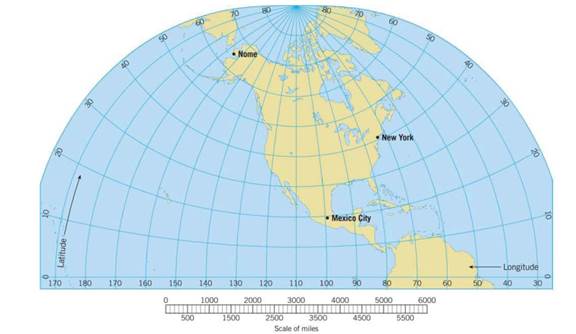
Use Figure 4.6 and a drafting compass to draw a circle around each of the three stations. Make the radius (in miles) of each circle equal to the station's distance from the epicenter as determined above. (Use the scale on the map to set the radius on the drafting compass). The Circles you draw should intersect at approximately one point. This point is the epicenter. If they do not intersect at one point, find a point that is equidistant from the edges of the three circles and use this as the epicenter. Label the epicenter on the map.
Figure 4.6 Map for locating an earthquake epicenter.

Learn your wayIncludes step-by-step video

Chapter 4 Solutions
MOD.MASTERING F/EARTH SCIENCE W/LAB MAN
Additional Science Textbook Solutions
Organic Chemistry (8th Edition)
Human Physiology: An Integrated Approach (8th Edition)
Chemistry: An Introduction to General, Organic, and Biological Chemistry (13th Edition)
Genetic Analysis: An Integrated Approach (3rd Edition)
Campbell Essential Biology with Physiology (5th Edition)
Campbell Biology (11th Edition)
- ''Discuss the role of natural disasters in the global epidemiology of gastroenteritis over the last 10 years.'' Including case studies of natural disaster events and gastroenteritis outbreaks (must be within the past 10 years)arrow_forwardWho wrote "there is no one is not better who has spent time in the presence of stones"arrow_forwardI need some help for Medical Microbiology , 'Discuss the role of natural disasters in the global epidemiology of gastroenteritis over the last 10 years.'arrow_forward
- Order this what come first 1.evaporation 2.transpiration 3. Warm air rises 4. Condensation 5. Precipitation 6.surface run off 7. Infiltration 8. Ground water storearrow_forwardI want to research desertification from 2020 to the presentarrow_forwardHow do i know where the arrows should point?arrow_forward
- Why is the Atlantic Ocean the saltiest ocean on Earth? In your explanation, use the terms “evaporation,” “precipitation,” “trade winds,” “Central America,” and “Pacific Ocean”.?arrow_forwardAt the large scale of the major ocean basins, do ocean currents tend to flow in a cyclonic or anti-cyclonic direction? How is this evidenced in the map of average sea-surface temperatures belowarrow_forwardThe map below shows sea-surface temperature (SST) anomalies during El Niño years. Please explain what is meant by “anomaly”. In El Niño years, which side (east or west) of the tropical Pacific Ocean experiences anomalously high precipitation totals and which side experiences anomalously low precipitation totals? Why?arrow_forward
- When a body of cold air near earth’s surface moves into a region occupied by warmer air, the point of intersection is known as a cold front. What does this do to the vertical motion of the warm air and why? What does this do to surface pressure ahead of the cold front and why ?Does this tend to instigate cyclonic or anti-cyclonic atmospheric rotation ? Does this rotation tend to bring relatively warm air toward the poles or toward the lower latitudesarrow_forwardAs the atmosphere and ocean move, they are deflected due to the spin of the earth. Is the deflection to the right or to the left in the Northern Hemisphere? Is this the same in the Southern Hemisphere ? In both hemispheres, a low pressure will instigate cyclonic flow. In the Northern Hemisphere, does cyclonic flow circulate in a clockwise or counter-clockwise direction and whyarrow_forwardIs the seasonal cycle in temperature (temperature difference between warmest and coolest season) stronger in the tropics or high latitudes, and why ?How about in “maritime” areas that are regularly exposed to air that was recently over the ocean versus more continental areas, and why?arrow_forward
 Applications and Investigations in Earth Science ...Earth ScienceISBN:9780134746241Author:Edward J. Tarbuck, Frederick K. Lutgens, Dennis G. TasaPublisher:PEARSON
Applications and Investigations in Earth Science ...Earth ScienceISBN:9780134746241Author:Edward J. Tarbuck, Frederick K. Lutgens, Dennis G. TasaPublisher:PEARSON Exercises for Weather & Climate (9th Edition)Earth ScienceISBN:9780134041360Author:Greg CarbonePublisher:PEARSON
Exercises for Weather & Climate (9th Edition)Earth ScienceISBN:9780134041360Author:Greg CarbonePublisher:PEARSON Environmental ScienceEarth ScienceISBN:9781260153125Author:William P Cunningham Prof., Mary Ann Cunningham ProfessorPublisher:McGraw-Hill Education
Environmental ScienceEarth ScienceISBN:9781260153125Author:William P Cunningham Prof., Mary Ann Cunningham ProfessorPublisher:McGraw-Hill Education Earth Science (15th Edition)Earth ScienceISBN:9780134543536Author:Edward J. Tarbuck, Frederick K. Lutgens, Dennis G. TasaPublisher:PEARSON
Earth Science (15th Edition)Earth ScienceISBN:9780134543536Author:Edward J. Tarbuck, Frederick K. Lutgens, Dennis G. TasaPublisher:PEARSON Environmental Science (MindTap Course List)Earth ScienceISBN:9781337569613Author:G. Tyler Miller, Scott SpoolmanPublisher:Cengage Learning
Environmental Science (MindTap Course List)Earth ScienceISBN:9781337569613Author:G. Tyler Miller, Scott SpoolmanPublisher:Cengage Learning Physical GeologyEarth ScienceISBN:9781259916823Author:Plummer, Charles C., CARLSON, Diane H., Hammersley, LisaPublisher:Mcgraw-hill Education,
Physical GeologyEarth ScienceISBN:9781259916823Author:Plummer, Charles C., CARLSON, Diane H., Hammersley, LisaPublisher:Mcgraw-hill Education,





